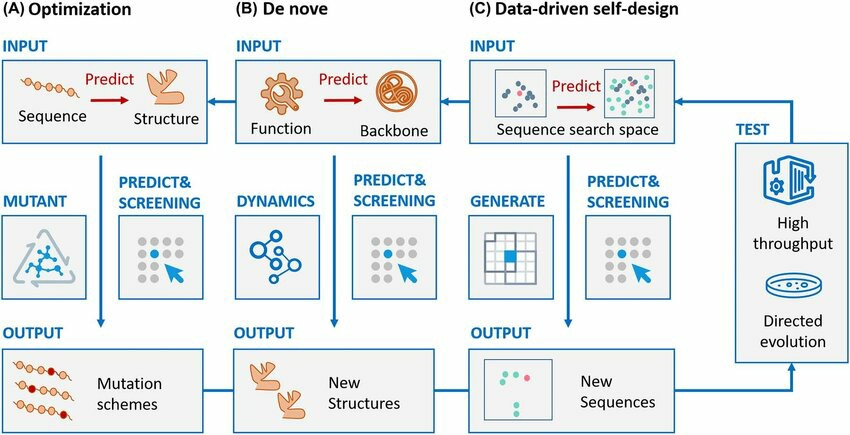01Overview
02Core Service Offerings
03Project Workflow
04Case Studies
05Frequently Asked Questions (FAQs)
06Contact Us
Overview
With the fast growth of AI, our company has implemented AI-guided design techniques for enzyme design. Combining machine learning with classical molecular simulations, we can quickly design enzymes that perform specific tasks, and thus solve traditional enzyme engineering problems. Our AI-enabled enzyme design not only enhances the efficiency of enzyme design but also generates enzymes that are not already present in nature, which opens new windows of biomedicine. Our company is rich with project research and development, technical team and can provide customers with single-stop service to accelerate research and development cycle and cut research and development cost.
 Enzyme design strategies and processes by AI (Yongfan Ming, et al., 2022)
Enzyme design strategies and processes by AI (Yongfan Ming, et al., 2022)
Core Service Offerings
AI-based enzyme design services primarily cover the following:
Sequence analysis and prediction of enzymes
Generate sequence - functional relationship of enzymes using generative AI technology and reveal behavioural and catalytic activity of enzymes. That entails making prediction about catalytic activity, stability and flexibility of enzymes, and finding novel functional enzyme sequences by means of AI models.
Calculation algorithms for enzyme design
Calculation algorithms, including computational protein design (CPD) and molecular dynamics simulations, are used to optimize the structure and function of enzymes. These techniques may allow the targeted binding and orientation of substrates at catalytic sites to be precise controlled and enhanced for enzyme selectivity and catalytic effectiveness.
Integrated enzyme sequence design and skeleton design
With AI, the amino acid sequence and three-dimensional skeleton design of an enzyme can be combined. It is a method of using, for example, neighborhood attention to make sure that different residues interact well.
Automated mining of enzymes with functionally important sites
AI algorithms are able to identify enzymes with functionally important sites, meaning sites that regulate enzyme function. Using these sites' data, the structure of enzymes can be programmed to serve certain purposes.
Identification of small molecule substrates
Enzyme design can use AI to recognise small molecule substrates and regulate enzyme/substratum interaction for better catalytic activity.
The Optimisation of enzyme-substrate interface
AI can make improvements to the enzyme-substrate interface to improve catalytic efficiency and selectivity of the enzyme. This involves altering and enhancing the enzyme's active site.
AI-supported enzyme design services extends across sequence design, functional site mining, substrate characterization, and experimental validation in order to optimize enzyme design and functional performance intelligently.
Project Workflow
The AI-driven enzyme design service process that we provide at our company is like this:
Designing enzyme strategy
Implementation of enzyme engineering
Performance testing and optimization
Customers feedback and iteration
- Customer needs analysis: First, our team will communicate in detail with customers about their needs and objectives. Such as enzyme design purpose, enzyme activity, stability needs, etc. This can also include digital tools and platforms that help in capturing and monitoring customer data.
- Designing enzyme strategy: Depending on the requirement of the customer, our professionals will design enzymes using sophisticated computing technology and machine learning technology. These could be protein structure predictions, enzyme activity classification, and a discovery of novel enzyme classes.
- Implementation of enzyme engineering: Once we identify the correct enzyme design approach, we are going to test and improve the designs experimentally. This could be the production of enzymes and the testing in the lab that the enzyme works as planned.
- Performance testing and optimization: The engineered enzyme will be subjected to the performance tests, such as activity, selectivity and stability. From these evaluation results, our group will continue to fine-tune and optimize the enzyme design for higher performance.
- Customers feedback and iteration: we will present customers with the original enzyme design and tweak as needed after customer feedback. This can take many tries to get the final product as satisfactory as possible for the customer.
- Supply and maintenance: After the customer accepts the design and performance of the enzyme, we will officially ship the product and offer necessary technical assistance and support after-sales service to make sure that the customer will be able to successfully use the new enzyme designed in the lab.
By doing so, we would be able to offer customers reliable and personalised AI-driven enzyme design services that will help them make innovations in areas like biomedicine.
Case Studies
Design of high-efficiency luminescent enzymes
Project background:
The scientists required an enzyme that would react with specific chemical building blocks and shine light. The standard enzyme design techniques take a long time, they're inefficient, and they can't keep up with new biosensors being developed at rapid speed.
Solution:
With the help of deep learning, we have developed a new luminescent enzyme that can identify chemical substrates and generate light-emission reactions.
Result:
Laboratory studies revealed that the new luminescent enzyme can catalyse effectively under specific conditions, and can deliver sensitive control of light signals for various purposes.
Frequently Asked Questions (FAQs)
In order to help customers better understand the AI-guided enzyme design services provided by our company, the following are some common questions and their detailed answers:
Q: What is AI-guided enzyme design?
A: AI-driven enzyme design is an approach that uses artificial intelligence to design and optimize enzymes. Automated extraction of functionally relevant sites and small molecule substrates will allow AI models to generate enzyme chains and three-dimensional structures with catalytic roles.
Q: How does the EnzymoGenius™ Technology model work?
A: EnzymoGenius™ Technology is a unified generation model for designing enzymes across all functional families. It simultaneously generates enzyme sequences and three-dimensional skeleton structures by automatically mining functionally important sites and given substrates. The model includes an enzyme modeling module and a substrate representation module that utilizes neighborhood attention isovariant layers (NAELs) to capture long-term correlations and local effects across the protein sequence
Q: What are the advantages of the EnzymoGenius™ Technology model?
A: EnzymoGenius™ Technology excels in multiple ways: first, it is able to design enzymes with high affinity for substrates; second, it is able to design well-folded enzymes with an average pLDDT score of 87.45, indicating a highly reliable structure
In addition, EnzymoGenius™ Technology performed best among all tested families, providing a 10.79% increase in substrate binding affinity over the best baseline method
Q: How does the EnzymoGenius™ Technology model differ from other methods?
A: Compared to other methods, EnzymoGenius™ Technology is the first unified generation model that works for all enzyme families. It not only considers the design of enzyme sequences, but also combines the three-dimensional structure design of the enzyme, and considers substrate constraints during the design process.
Q: How to use EnzymoGenius™ Technology for enzyme design?
A: Enzyme design using EnzymoGenius™ Technology requires providing information about the target enzyme family, substrates, and functionally important sites. The corresponding enzyme sequence and three-dimensional structure were then generated using the EnzymoGenius™ Technology model. The process includes joint training goals of loss of sequence generation, loss of position prediction, and loss of enzyme-substrate interactions
Q: What are the application areas for the EnzymoGenius™ Technology model?
A: The EnzymoGenius™ Technology model is widely used in fields such as pharmaceuticals, specialty chemicals and biofuels. It can help accelerate chemical reactions, improve production efficiency, and play an important role in drug discovery and development.
Q: What are the steps involved in the design process of an EnzymoGenius™ Technology model?
A: The design process includes the following steps: first, automatically mining functionally important sites and substrates; second, using NAELs to capture long-term correlations and local effects; and finally, generating enzyme sequences and three-dimensional structures by jointly training targets
Q: What are the evaluation criteria for the EnzymoGenius™ Technology model?
A: Evaluation criteria for the EnzymoGenius™ Technology model include enzyme-substrate ESP score, substrate binding affinity, and AlphaFold2 pLDDT score. These indicators together assess the quality and function of the enzyme
Through these questions and answers, customers can better understand the advantages and application areas of the AI-guided enzyme design services provided by our company.
By combining advanced AI technology with huge biological data sets, we are able to unlock new design spaces and bring unprecedented opportunities for enzyme engineering. Our AI tools not only speed up the computing process, but also guide mutation and structural design from scratch. If you are looking for an efficient and innovative way to optimize your enzyme engineering process, please contact us.

































 Enzyme design strategies and processes by AI (Yongfan Ming, et al., 2022)
Enzyme design strategies and processes by AI (Yongfan Ming, et al., 2022)